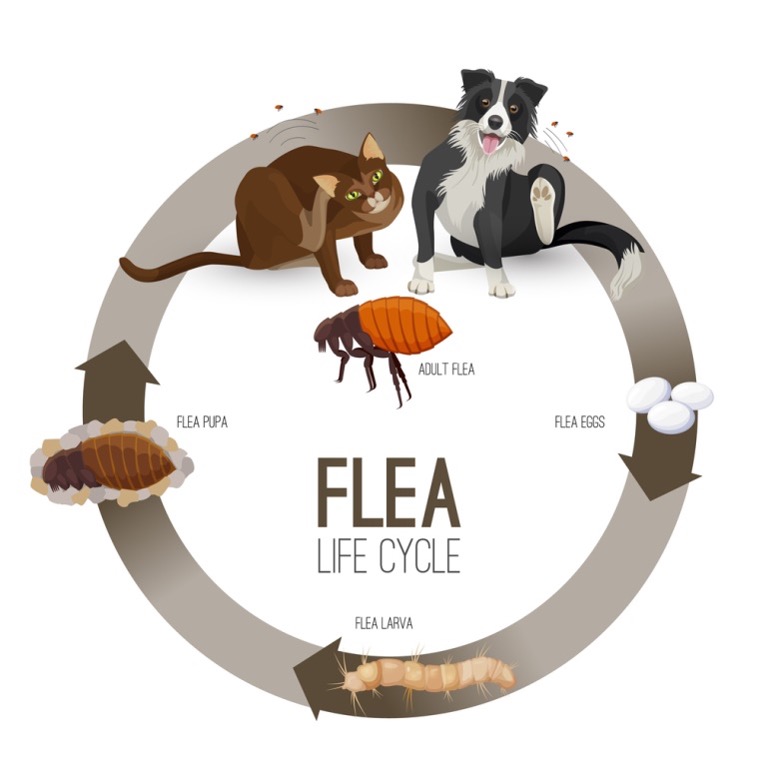It seems like summer has taken a jump on us even though we are still in spring. But, for sure, with the warmer weather here in Santa Clarita, we must deal with pests and how they affect our pets. In this article, I will talk about fleas, ticks, and mosquitos because they can cause a lot of harm to our pets. These pets can harm all pets, particularly dogs, cats, and ferrets. Pest prevention is the best remedy. But before we go into that, let’s talk about some basics.
Fleas

Fleas are brown or reddish-brown insects that have flat bodies and feed by sucking blood from animals and humans, causing itchy bites. They are very small (about 3 mm long). Although fleas are tiny, they can make your pet’s life miserable. Once on your pet, fleas can bite up to every 5 minutes leaving your pet itchy, sore, and uncomfortable. Even just one bite can cause an allergic reaction in a pet.
One of the most amazing but frustrating things about fleas is their ability to jump. A flea can jump vertically up to 7 inches and horizontally up to 13 inches. Relative to its size, the flea is one of the best jumpers of all animals.
How do you know if your pet has fleas?
- Little dark spots that move in the fur.
- Small black particles (flea droppings, also called flea dirt). An easy way to spot these is by using a flea comb. Comb your pet’s fur with the flea comb and wipe the comb through a wet paper towel. When the flea dirt gets wet it turns a reddish or brown color. This is from the digested blood of your pet that the fleas excrete.
- Your pet is scratching more than normal. Just like humans, pets will scratch from time to time. But if your pet is frequently scratching they may have fleas.
- Reddened patches and irritation on your pet’s skin.
How does your pet get fleas?

The most likely way your pet will get fleas is through exposure from other animals. Fleas can easily jump onto your pet from other animals. Opossums, raccoons, squirrels, and rats are known to carry fleas that can infest your pet. However, wild animals don’t have to have direct contact with your pet to transmit fleas. Fleas lay eggs on their host. These eggs can drop off the host and into your yard. The eggs hatch and the flea larvae develop hidden in the grass or duff (decaying leaves and branches) outside. The larvae then become pupa as in the picture above. Then as adults, they wait for an animal to pass by and jump on.
Importance of Treating Your Pet for Fleas
Fleas can cause a host of problems in pets:
- Persistent scratching, over-grooming, and skin infections.
- Anemia. For example, small cats or kittens that are heavily infested can lose so much blood to the biting fleas and ticks that they become anemic. It can become so severe that the cat can die.
- Tapeworms
- Bacterial diseases, e.g. bubonic plague
- Hookworms
Ticks
Ticks are eight-legged bugs that have highly developed mouth parts that can pierce the skin of your pet and feed on their blood. Depending on the type of tick, they may be different in colors such as grey, brown, black, reddish-brown, or yellow. They feed on blood to survive and produce eggs. The eggs develop into larvae, then nymphs, and finally, adult ticks. Tick larvae are very small (the size of a grain of sand). An adult tick can start very small (e.g. the size of an apple seed). But as they feed off a pet they grow in size.
How do pets get ticks?
Ticks are most commonly found outdoors in leaf litter, shrubs, or bushes. Ticks also exist in non-wooded areas. They can also be found in tall grasses. Ticks can’t jump like fleas. Instead, they grab onto and cling onto passing animals.
It is important to check your pet for ticks after you’ve spent any time outdoors. If you feel a small bump on your pet, be sure to part your pet’s fur and take a closer look. Unfortunately, it is not always easy to spot a tick in your pet’s fur. Some other signs your pet might have a tick:
- You find a tick in your home.
If you see a tick in your bedsheets, carpet, or on the floor, this is a sign that a member of your family or your pet may have brought a tick into the house. Be sure to do a closer examination of your pet’s fur. - Your pet is shaking its head a lot.
Ticks like to attach to moist environments, and are many times found around the ears of a pet. If your pet is shaking its head excessively, have a closer look at its head and inside its ears. - You find scabs on your pet.
Ticks bite and feed on blood. If the tick detaches or is removed by your pet licking or scratching, a scab may form. Take a closer look at any unexplained scabs you notice on your pet’s body. - Your pet has symptoms of a tick bite.
If your pet has a fever or experiences fatigue, loss of appetite, vomiting, lameness, or other unusual symptoms this may indicate that your pet has been infected by a tick-transmitted disease. In some cases, reactions to ticks can be life-threatening. Therefore, if you notice any unusual symptoms call your vet immediately.
TREATMENT FOR FLEAS
If your pet already has a flea infestation there are several steps you will need to take to get rid of the fleas:
- Treat Your Pet. Contact your veterinarian and find out the right treatment for your pet.
- Use a powerful vacuum. Vacuum floors, upholstery, and mattresses. Cracks and other tight spaces are usually good hiding places for fleas and their eggs, larvae, and cocoons. If you can, use a vacuum with a bag you can dispose of without coming into contact with its contents.
- Use a steam cleaner for carpets and upholstery, including pet beds. The combination of high heat and soap is the enemy of fleas in all stages of life. Pay special attention to any hot spots where your pet usually lies down.
- Wash all bedding, including your pet’s, in hot water. Dry it at the highest heat setting. If the infestation is severe, consider getting rid of old bedding and starting anew.
- Use flea traps. There are flea traps on the market that can help to eliminate and help prevent flea infestations. One of these is the Victor M230A Ultimate Flea Trap sold by Home Depot and Amazon.
TREATMENT FOR TICKS
Remove the tick as soon as possible
- Use fine-tipped tweezers to grasp the tick as close to the skin as you can.
- Pull upward with steady, even pressure. Don’t twist or jerk the tick.
- After removing the tick, clean the bite area and your hands with rubbing alcohol or soap and water.
- Place the tick in a plastic bag with alcohol (to kill it). If your pet gets ill you may need to show the tick to your veterinarian so they can see what type of tick bite your pet.
Watch for any of the above tick bite symptoms and if any, contact your veterinarian.
Fortunately most tick-borne illnesses respond quickly and completely to a course of antibiotics, so prompt veterinary attention is best for your pet.
PREVENTATIVE TREATMENT FOR FLEAS & TICKS
The best treatment for fleas and ticks is PREVENTATIVE treatment. There are various brands of treatment that cover both fleas and ticks.
*Important note: make sure you get the right treatment for your pet, especially for your pet’s weight. For example, using flea treatment meant for a dog on a cat or giving too high a dose to an animal can be fatal. Check with your veterinarian so you can be sure you are using the right treatment.
Pest Prevention — Mosquitos and Heartworm

Heartworm gets its name from the worms that grow and reproduce in the heart of an animal. Mosquitos transmit the worms through their bite on your pet. It causes a severe and potentially fatal disease that can cause heart failure, lung disease, and other organ failures.
What happens is that once your pet is infected, foot-long worms begin to grow inside of your pet’s body (yuck!) and can inhabit their heart, lungs, and various blood vessels.
The best way to stop heartworm is to talk to your veterinarian about preventing heartworm and getting your pet tested for it annually. It is more common for dogs to get heartworm, but cats and ferrets can get it too.
Symptoms:
- Occasional or persistent coughing: As the heartworm progressively gets worse, your pet’s cough will become more frequent, but you shouldn’t ignore even a mild one.
- Trouble breathing: As the disease progresses, breathing may become more and more labored.
- Tiring quickly: With blood flow being blocked or at least partially blocked, your pet will become tired much more rapidly, so be sure to bring them in even if you’re not sure what’s wrong.
Only a veterinarian can treat heartworm disease. There is no at-home treatment for heartworm. The treatment for heartworm disease is not easy on a pet and can be toxic to the pet’s body. It can cause serious complications, such as life-threatening blood clots to the lungs. Additionally, the treatment is expensive. It requires multiple visits to the veterinarian, blood tests, x-rays, hospitalization, and a series of injections.
Considering the devastation heartworm causes to a pet’s health, we strongly urge you to consult with a veterinarian and immediately start heartworm prevention treatment so your pet never has to suffer from an infestation.
If you’re interested in studying more about heartworm, go to www.heartwormsociety.org
Summary
We provide treatment and mediations for fleas, ticks, and heartworm disease caused by mosquitos. Keep your pets safe this summer and contact us for preventative medications or if you think your pet might be suffering from any of the above symptoms.
Sincerely,
Jaimie Ronchetto, DVM
Cinema Veterinary Center
Santa Clarita, CA

